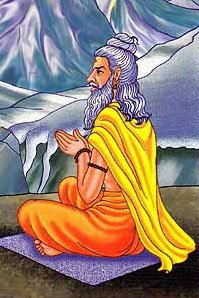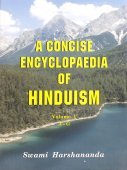Animandavya, Aṇimāṇḍavya, Ani-mandavya: 7 definitions
Introduction:
Animandavya means something in Buddhism, Pali, Hinduism, Sanskrit. If you want to know the exact meaning, history, etymology or English translation of this term then check out the descriptions on this page. Add your comment or reference to a book if you want to contribute to this summary article.
In Hinduism
Purana and Itihasa (epic history)
Source: archive.org: Puranic EncyclopediaAṇimāṇḍavya (अणिमाण्डव्य).—General. How he got the name Aṇimāṇḍavya. Once there was a famous Brahmin named Māṇḍavya. He did Tapas (penance) for many years standing silent in front of his Āśrama, under a tree, raising his hands in prayer. At that time some thieves happened to pass by that place, with stolen property belonging to the King. Finding that the King’s men were pursuing them, the thieves fled away after leaving their stolen property in Māṇḍavya’s Āśrama. The King’s men seized Māṇḍavya with the king’s property. Even prolonged and repeated questionings did not bring out a single word from Māṇḍavya. At last the thieves were caught. Mistaking him as one of the thieves, the King’s men produced Māṇḍavya also along with the thieves before the King. The thieves were all condemned to death. The royal executioners took all of them to the place of execution and stuck them up at the tip of a trident (Śūla). The thieves died, but even after a long time Māṇḍavya did not die. In Mahābhārata, Anuśāsana Parva, Verses 4651, it is said that at this stage Śiva appeared and blessed him with longevity and then vanished. Several Munis in the shape of birds came near Māṇḍavya who was lying on the trident and made enquiries about him. The King came to know of all these stories. Full of repentance, he went and begged pardon of Māṇḍavya. The attempt to pull out the trident from Māṇḍavya’s body failed. At last it was removed by cutting it off. Since the tip (Aṇi) of the trident was left behind in his body he was thereafter known as "Aṇi Māṇḍavya". (Mahābhārata, Ādi Parva, Chapter 107). (See full article at Story of Aṇimāṇḍavya from the Puranic encyclopaedia by Vettam Mani)

The Purana (पुराण, purāṇas) refers to Sanskrit literature preserving ancient India’s vast cultural history, including historical legends, religious ceremonies, various arts and sciences. The eighteen mahapuranas total over 400,000 shlokas (metrical couplets) and date to at least several centuries BCE.
In Buddhism
Theravada (major branch of Buddhism)
Source: Pali Kanon: Pali Proper NamesSee Animandavya.
-- or --
See Mandavya.
Theravāda is a major branch of Buddhism having the the Pali canon (tipitaka) as their canonical literature, which includes the vinaya-pitaka (monastic rules), the sutta-pitaka (Buddhist sermons) and the abhidhamma-pitaka (philosophy and psychology).
Languages of India and abroad
Sanskrit dictionary
Source: DDSA: The practical Sanskrit-English dictionaryAṇimāṇḍavya (अणिमाण्डव्य).—[aṇyā cihnito māṇḍavyaḥ] Name of a sage said to have been impaled on an अणी (aṇī) or linchpin. स तथान्तर्गतेनैव शूलेन व्य (sa tathāntargatenaiva śūlena vya)रन् मुनिः (ran muniḥ) | ...अणीमाण्डव्य इति च ततो लोकेषु गीयते (aṇīmāṇḍavya iti ca tato lokeṣu gīyate) || Mahābhārata (Bombay) 1.18.7-8.
Derivable forms: aṇimāṇḍavyaḥ (अणिमाण्डव्यः).
Aṇimāṇḍavya is a Sanskrit compound consisting of the terms aṇi and māṇḍavya (माण्डव्य).
Source: Cologne Digital Sanskrit Dictionaries: Monier-Williams Sanskrit-English DictionaryAṇīmāṇḍavya (अणीमाण्डव्य):—[=aṇī-māṇḍavya] [from aṇī > aṇ] m. Name of a Brāhman ascetic (said to have been impaled on an aṇi or point of a stake), [Mahābhārata]
Source: Cologne Digital Sanskrit Dictionaries: Goldstücker Sanskrit-English DictionaryAṇīmāṇḍavya (अणीमाण्डव्य):—[tatpurusha compound] m.
(-vyaḥ) The name of a Ṛṣi or Saint. E. aṇī, a pin, and māṇḍavya; according to the comm., aṇī would be in this word a qualification of the proper name māṇḍavya; from his being impaled on a śūla or aṇī.
[Sanskrit to German]
Sanskrit, also spelled संस्कृतम् (saṃskṛtam), is an ancient language of India commonly seen as the grandmother of the Indo-European language family (even English!). Closely allied with Prakrit and Pali, Sanskrit is more exhaustive in both grammar and terms and has the most extensive collection of literature in the world, greatly surpassing its sister-languages Greek and Latin.
See also (Relevant definitions)
Partial matches: Mandavya, Ani.
Full-text: Yannadatta, Mandavya, Kanhadipayana Jataka, Shilavati.
Relevant text
Search found 3 books and stories containing Animandavya, Aṇimāṇḍavya, Ani-mandavya, Aṇi-māṇḍavya, Aṇīmāṇḍavya, Aṇī-māṇḍavya; (plurals include: Animandavyas, Aṇimāṇḍavyas, mandavyas, māṇḍavyas, Aṇīmāṇḍavyas). You can also click to the full overview containing English textual excerpts. Below are direct links for the most relevant articles:
Puranic encyclopaedia (by Vettam Mani)
Mahabharata (English) (by Kisari Mohan Ganguli)
Dvisahasri of Tembesvami (Summary and Study) (by Upadhyay Mihirkumar Sudhirbhai)
The story of Lord Dattātreya’s birth < [Introduction]
Related products
